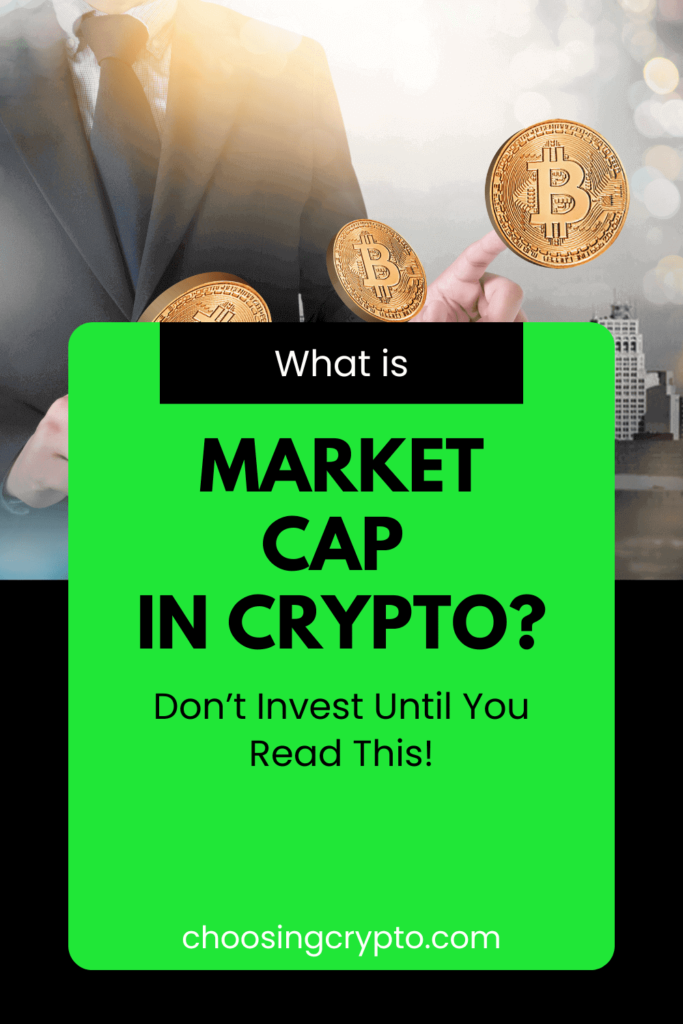Market cap in crypto is one of the most used metrics, but it is also one of the most misunderstood. Many think it shows how much money has been invested in a project. That’s not true.
Before putting money into any cryptocurrency, you need to know what the market cap really tells you and what it doesn’t. A simple mistake could make you miss great opportunities or, worse, lead to costly losses.
This post breaks down what market cap in crypto really is, why it’s more than just a number, and the flaws most people overlook. If you want an edge in crypto, keep reading.
What is Market Cap in Crypto?
Market cap, or market capitalization, is the total value of a cryptocurrency. It’s calculated with a simple formula:
Current Price × Circulating Supply = Market Cap
For example, if a coin is priced at $100 and has 10 million coins in circulation, the market cap would be 100 × 10,000,000 = $1 billion.
Investors use market cap to compare cryptos. A higher market cap often means a more established project. At the same time, a lower one usually comes with more risk and volatility. But the market cap in crypto doesn’t tell the whole story. Many think it shows the total money invested in a cryptocurrency, but it’s just a price-and-supply calculation. It doesn’t measure liquidity, real investment, or long-term potential.
Types of Market Cap in Crypto
Cryptocurrencies come in different sizes and risks. Market cap divides them into three main groups.
- Large-Cap Cryptos—Safe but Slow Growth: These are the biggest names in crypto, usually worth over $10 billion. Bitcoin and Ethereum fall into this category. They are more stable and less volatile due to strong adoption, liquidity, and institutional backing. While they won’t deliver overnight 100x gains, they are considered safer for long-term investment.
- Mid-Cap Cryptos—A Balance of Risk and Reward: These have a market cap between $1 billion and $10 billion. Many have solid technology and growing adoption, making them attractive for investors looking for strong returns without extreme risk. However, they remain more volatile than large caps.
- Small-Cap Cryptos—High Risk, High Reward: Any crypto with a market cap under $1 billion falls into this category. This includes meme coins, emerging DeFi projects, and niche altcoins. Some can deliver 1000x gains, but they are also the most volatile. Their value often depends on speculation, hype, and market sentiment, making them the riskiest option.
Understanding these categories helps manage risk. Large-caps offer stability, mid-caps balance safety and growth, and small-caps appeal to those willing to take big risks for the chance of massive rewards. A smart crypto portfolio considers all three.
Want to track the real-time performance of large, mid, and small-cap cryptos? Here are the best websites to check live prices and market cap trends.
Why Market Cap in Crypto Matters Before Investing
Market cap in crypto is more than just a number. It helps assess risk, compare assets, and make smarter investments. Before putting money into any cryptocurrency, here’s why market cap should be one of your first considerations.
- Measures a Coin’s Stability: Larger market cap cryptos like Bitcoin and Ethereum tend to be more stable. They have strong liquidity, meaning enough trading volume exists to prevent sudden crashes. Smaller market cap cryptos, on the other hand, can be highly volatile. While they offer the chance for massive gains, they also carry the risk of rapid losses.
- Helps Compare Cryptos Accurately: Many beginners focus on a coin’s price without considering the market cap, which can be misleading. A coin priced at $0.50 with 1 billion tokens in circulation has a $500 million market cap. Another coin priced at $500 with only 100,000 tokens in circulation has a $50 million market cap. Even though the second coin looks more expensive, the first one is actually ten times larger in total value.
- Prevents the Low-Price Misconception: A coin priced at $0.01 may seem like a bargain, but price alone doesn’t determine potential. Market cap and total supply matter more. If a coin has 10 trillion tokens in circulation, it would take an unrealistic amount of investment to reach $1 per coin.
- Highlights Growth Potential: Smaller market cap cryptos often have more room to grow but come with higher risk. Large-cap cryptos already have widespread adoption, so their growth is slower but more stable. Investors looking for bigger returns might find better opportunities in mid-cap or small-cap cryptos, though these require more research and a higher risk tolerance.
- Helps Build a Balanced Portfolio: Diversification is key in crypto investing. A well-balanced portfolio includes large-caps for stability, mid-caps for growth, and small-caps for high-risk, high-reward opportunities.
Market Cap vs. Fully Diluted Market Cap: The Key Difference
Market cap and fully diluted market cap (FDV) are often mistaken for the same thing, but they measure different aspects of a cryptocurrency’s value. Knowing the difference can help you avoid overpaying for a token or misjudging its potential.
Market Cap: The Current Value of a Crypto
Market cap represents the total value of a cryptocurrency based on its circulating supply. It’s calculated as:
Market Cap = Current Price × Circulating Supply
This figure shows the value of the coins currently in circulation, making it useful for comparing crypto projects. However, it doesn’t account for future token supply increases.
For instance, if a token is priced at $10 and has 10 million coins in circulation, its market cap is $100 million (10 × 10,000,000). While this reflects the current value, it doesn’t indicate how future token releases might impact the price.
Fully Diluted Market Cap (FDV): The Value at Full Supply
FDV estimates the potential total value of a cryptocurrency if all its tokens are in circulation. The formula is:
FDV = Current Price × Maximum Supply
This metric helps assess how future token releases might affect a project’s valuation, though it can sometimes overestimate worth, especially if new tokens are released gradually over many years.
Using the same example, if the maximum supply is 100 million tokens, then FDV would be $1 billion (10 × 100,000,000). This suggests that if all tokens were available today at the same price, the total market cap would be 10 times higher than its current level.
Why It Matters
Many investors focus only on market cap, but ignoring FDV can lead to costly mistakes. If FDV is significantly higher than the current market cap, future token releases could dilute supply and push prices down. Conversely, if FDV is close to market cap, the token has lower inflation risk and may hold its value better.
For example, if only 10% of a project’s tokens are in circulation while 90% remain locked, future releases could flood the market, increasing supply and lowering prices. Understanding both market cap and FDV allows you to make smarter investment choices and anticipate potential price changes due to supply dilution.
Additional Resources:
- How to Check the Market Cap of a Crypto
- 7 Best Ways to Secure Your Crypto
- Essential Things to Know Before Investing in Cryptocurrency
- How to Research a Crypto Project Properly Before Investing
And guess what? We’re also on Instagram and X (Twitter). Join us there for even more fun and useful content!

DISCLAIMER:
The information provided here is for informational purposes only. Do not rely solely on it for making investment decisions. It is not financial, tax, legal, or accounting advice. Always do your own research or consult a financial advisor before investing in cryptocurrency.
